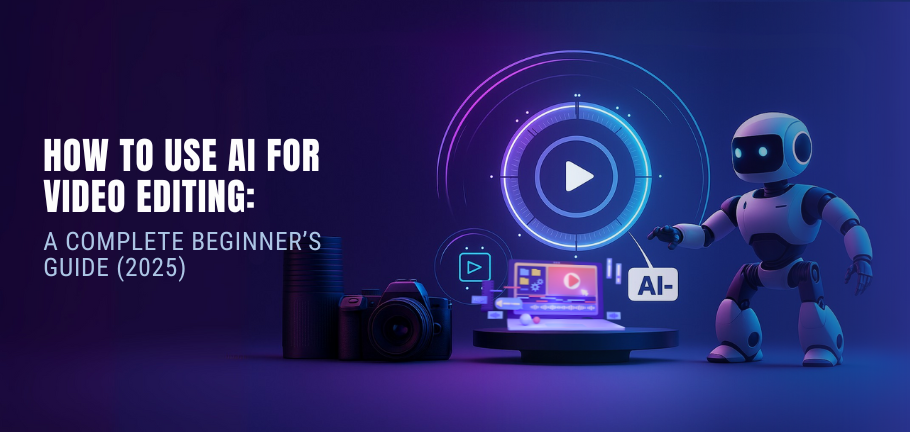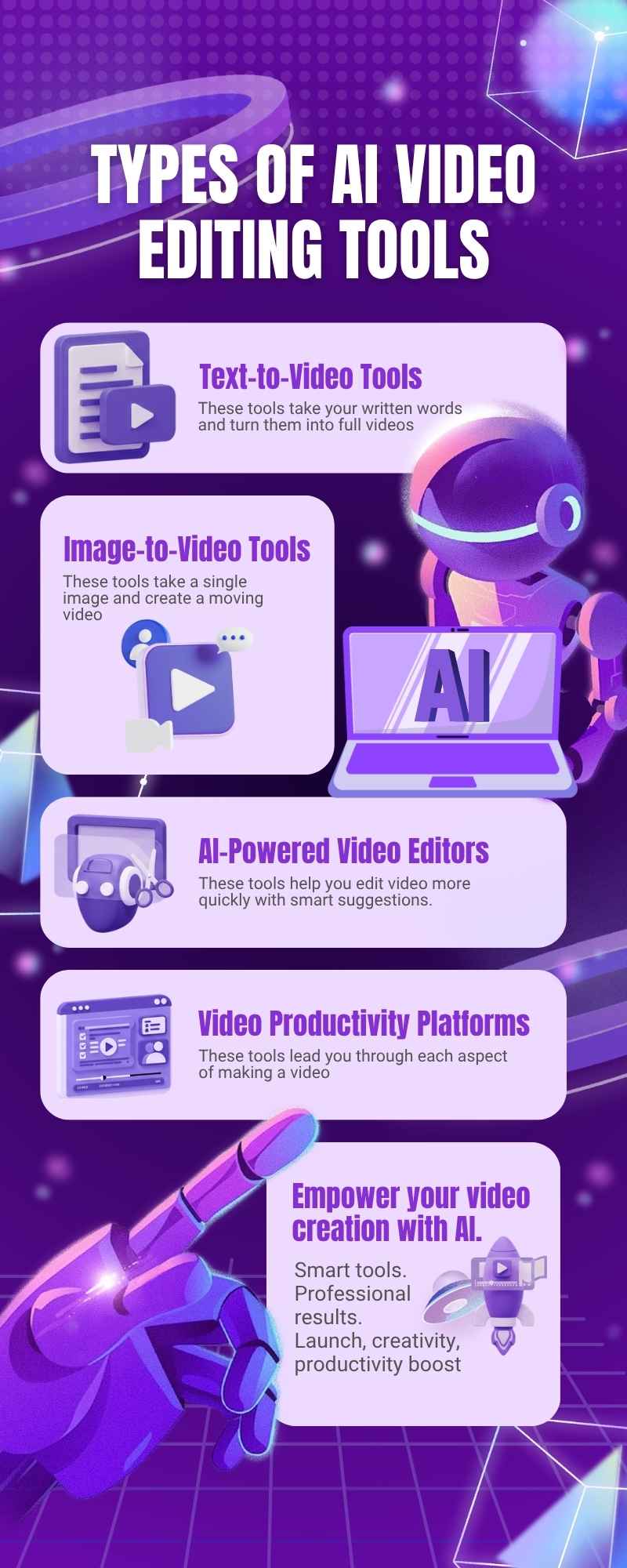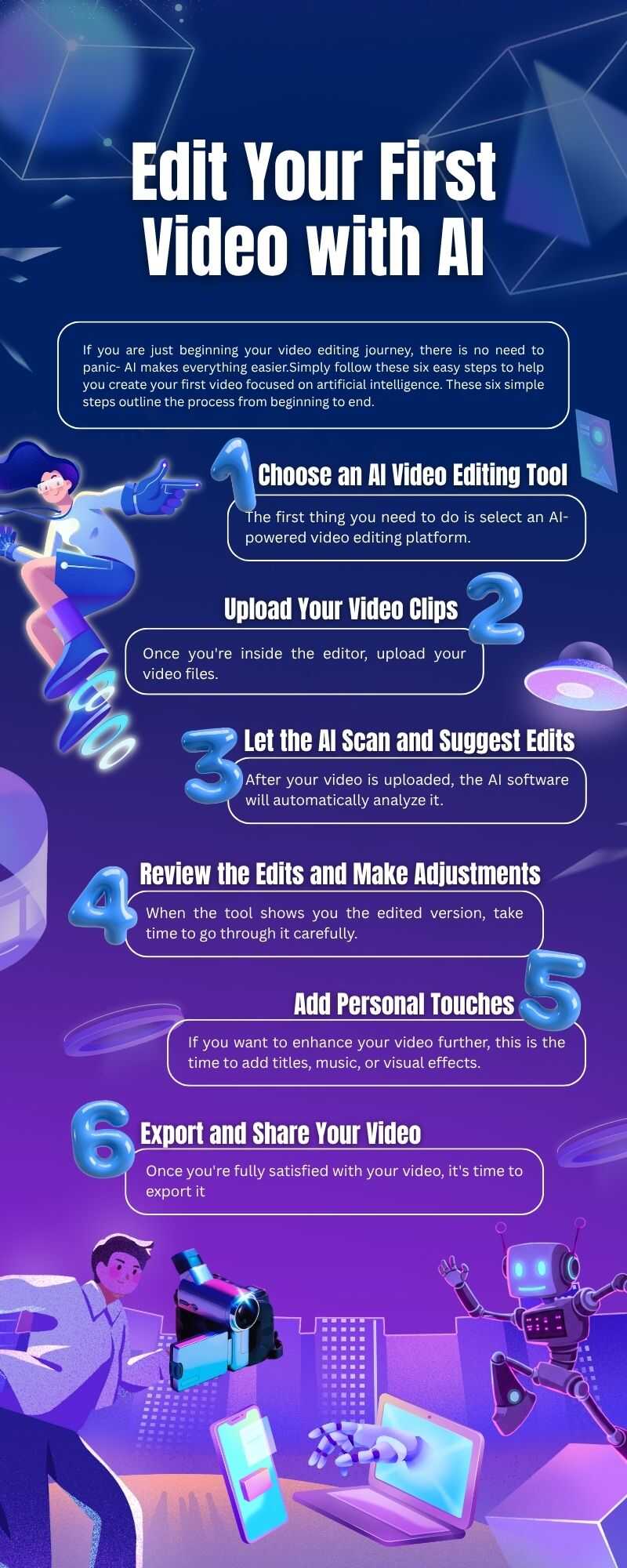In 2025, AI for video editing will ensure that video creation is no longer reserved for professionals with expensive software and years of experience. Video editing is increasingly being transformed with the help of artificial intelligence, which now lets anyone produce beautiful, professional-looking videos with minimal effort. The best AI for video editing is optimizing the whole process, it’s making it faster, easier, and smarter. It reduces the editing workload by automatically performing major tasks like trimming clips, adding background music, generating subtitles or captions, and inserting transitions, to name a few. Even the best AI for video editing free tools now make it easier for complete beginners to enter the video creation arena without feeling overwhelmed.

Video is the most effective way to grab attention in the digital age. Research shows that visuals account for over 80% of human memory, compared to just 20% of human memory with audio alone. With users now able to watch more than an incredible 33 hours of video per week, it is imperative for creators to include faster and smarter approaches to video production, including the evolving platforms of AI.
AI is changing the way we use video and tell stories in the online space. It eliminates much of the grunt work of video editing, from cutting and sequencing clips, adding effects, syncing sound, and even generating content from nothing. No matter the type of online creator on social media or marketers for businesses, AI is taking the work out of video creation, while significantly increasing efficiency, creativity, ease, and access.
AI video editing refers to the use of artificial intelligence to automate or assist in the video editing process. Rather than conducting various edited clips and adding effects by hand, AI tools can do this on your behalf using smart algorithms. Some of these tools are capable of generating entire videos based on text, images, or prompts, for instance.
As a result, you don’t need to spend large amounts of money on expensive gear or professional skills to create polished videos. Simply enter your idea and let the AI software take over – cutting the scenes you want it to cut, adding the music, and even generating subtitles or voiceovers! These tools are built for beginners and are suited for someone who has never edited before.
AI video generators are an example of a series of programs that utilise machine learning and natural language processing to analyse an input source, such as a script, voice or visual, and produce professional-looking video content. When generating the final video, AI video generators will identify components such as subjects, emotions, lighting, and even audio inputs, which often pair well with AI voice generator tools for adding natural voiceovers.
Suppose you provide a script to an AI generator that says, “A smiling woman walks through a sunflower field.” The AI generator will search its library for relevant visual components, animate the components, and most likely source appropriate background music to fit the scene, all within a few minutes, something that would normally take hours or days to accomplish using traditional methods.

AI video tools generally fall into three main categories:
These tools take your written words and turn them into full videos. You simply type in a script or prompt, and the AI will add footage that matches the script, plus a voiceover and background music. Perfect for explainer videos or stories. You don’t need to have any video editing skills—just your ideas.
These tools take a single image and create a moving video. You upload a photo, and the AI will add actions such as blinking, smiling, or looking around. For high-quality visuals, many creators use free image generation tools to produce realistic photos before animating them. They’re great for making animated portraits or bringing old photos to life. You make the animated motion with a short prompt.
These tools help you edit video more quickly with smart suggestions. They’ll remove silences, add smooth transitions, correct lighting, and align your script or subtitles to your voice. It’s like having the ultimate editor. You are still doing the editing, but AI makes it easier. You can even select different tones and styles of voice to match your visuals, depending on the AI voice type you prefer.
These tools lead you through each aspect of making a video. From writing your script to editing and exporting the final video, AI helps you through each part of the process. If you’re a team or a creator that needs an all-in-one solution, these tools enable you to do it all in one place, quickly and smoothly.
If you are just beginning your video editing journey, there is no need to panic- AI makes everything easier. You do not need to be a technical genius. Simply follow these six easy steps to help you create your first video focused on artificial intelligence. These six simple steps outline the process from beginning to end.

The first thing you need to do is select an AI-powered video editing platform. Many of these tools are web-based, which means you don’t have to download anything. Simply go to the website, create an account, and start editing. Choose a platform that has a clean interface, basic editing features, and AI assistance for tasks like trimming, captions, or adding music.
Once you’re inside the editor, upload your video files. You can usually drag and drop your footage into the workspace. Most platforms allow uploads from your device, cloud storage, or even let you record a clip directly from your camera. If your file size is large, give it a moment to process—this is completely normal.
After your video is uploaded, the AI software will automatically analyze it. This may take a few seconds. Based on what it detects—like speech, faces, or scenes—the AI will recommend edits. These suggestions might include removing silent parts, trimming unnecessary sections, syncing the audio with visuals, improving lighting, or even generating captions and subtitles automatically.
When the tool shows you the edited version, take time to go through it carefully. Watch the full video from start to finish. If something seems off, don’t worry—almost all tools let you adjust manually. You can shift clips, edit text or subtitles, change music, and refine transitions. Think of this step as giving your video its personality and final polish.
If you want to enhance your video further, this is the time to add titles, music, or visual effects. Many editors come with built-in royalty-free music libraries, animated text, and video filters. Use these features to match your video’s tone or message. A simple title or smooth background track can make a big difference. Just remember—less is more. Keep things clean and easy to follow.
Once you’re fully satisfied with your video, it’s time to export it. Choose your desired video resolution—720p or 1080p works well for most uses—and give your video a name. Then, download it to your device or share it directly to your social media, website, or video platform. The exporting process might take a few minutes depending on the video’s length and the quality settings you selected.
Writing good prompts is key to getting high-quality results from AI tools. Start with a simple formula:
Prompt = Subject + Motion + Scene
Example: “A cat, sleeping on a windowsill, in a sunlit room”
To take it further, use an advanced version:
Prompt = Subject (Description) + Motion + Scene (Details) + Camera + Lighting + Atmosphere
Example: “A fluffy orange cat, slowly blinking, lying on a windowsill with soft white curtains, captured in a warm afternoon glow with a close-up camera angle”
This level of detail helps the AI better match your vision.
Adobe Premiere Pro is a professional video editor known for its powerful features and smooth workflow. It lets you cut, trim, and edit videos on a timeline and works perfectly with other Adobe apps like After Effects and Photoshop. The AI tools help with tasks like auto-reframing, color grading, and scene detection, saving you time.
While it’s more advanced, Premiere Pro is ideal for serious creators, filmmakers, and YouTubers. It requires a monthly subscription, but it’s worth it if you want studio-level results. There are many tutorials online, making it easier for beginners to learn over time.
DaVinci Resolve is a free, professional-grade video editor used by both beginners and movie editors. It offers top-notch tools for color grading, audio mixing, and visual effects. The built-in AI helps with smart cropping, facial recognition, and auto-enhancements.
It’s powerful yet accessible, and doesn’t cost a thing to get started. While it has many features, beginners can learn quickly using free online tutorials. It’s perfect for creators who want advanced tools without paying for expensive software.
Final Cut Pro is Apple’s premium video editing software, made for Mac and iPad users. It features a clean interface and a smart “magnetic timeline” that keeps clips organized. It supports 8K editing, fast rendering, and AI tools like auto-cropping.
Though it’s a paid tool, you only pay once instead of monthly. It’s great for creators who want high-quality editing and fast performance, especially on Apple devices. It’s beginner-friendly yet powerful enough for professionals.
CapCut is a free, easy-to-use mobile video editor that’s perfect for TikTok, Instagram, and YouTube Shorts. It offers trendy effects, auto captions, background removal, and even supports 8K video exports—all from your phone or browser.
It’s ideal for beginners and content creators who want fast, fun editing with little effort. It’s completely free and works on phones, tablets, and desktops, making it one of the most flexible tools out there today.
Filmora is a user-friendly video editor with drag-and-drop simplicity. It includes built-in templates, AI tools for music and transitions, and solid 4K support. It’s designed to help beginners make polished videos fast.
The software is affordable, with both free and paid versions. It’s perfect for vloggers, students, and social media creators who want professional-looking results without a complex setup.
AI for video editing has completely changed how people make videos in 2025. What used to take hours or even days can now be done in just minutes, thanks to smart tools that help with cutting, adding music, subtitles, and even creating entire videos from just text. These tools are perfect for beginners because they don’t need any special skills or expensive equipment. Whether you want to make fun videos for social media, explain a product, or teach something online, the best AI for video editing makes it quick and easy.
The best part is that many of these tools are free or very affordable. Even the best AI for video editing free options offer incredible features without compromising quality. You can start small, learn as you go, and grow your skills over time. AI doesn’t replace your creativity; it supports it. So if you have a story to tell or an idea to share, there’s no better time than now to try AI for video editing. It’s simple, fast, and powerful, and it’s here to help you create amazing videos.
What are the benefits of using AI for video editing?
AI automates editing tasks like trimming, transitions, and captions, saving time. It makes high-quality video creation easier for beginners and small teams. Many tools include built-in templates and royalty-free media. The best AI for video editing improves workflow and boosts creativity. It also reduces costs compared to traditional editing software.

What are the limitations of using AI for video editing?
AI may not fully understand creative storytelling or emotional context. Some tools have limited custom options or watermark restrictions. Free editors might lack advanced features or output resolution. Generated subtitles or scene cuts can require manual tweaks. Overall, it’s smart but still benefits from human refinement.

How to use AI for video editing?
Start by selecting an AI-powered video editing tool or platform. Upload your video files or script, then let the AI scan and edit. Review suggestions like trimming, subtitles, or lighting enhancements. Manually refine the video to personalize it further. Export your video and share it online—quick, easy, and professional.

Which AI is best for video editing?
Popular choices include Adobe Premiere Pro, CapCut, DaVinci Resolve, and Filmora. CapCut is great for mobile creators, while Premiere Pro is more advanced. DaVinci Resolve offers pro-level features for free. Final Cut Pro is perfect for Apple users seeking high performance. Choose based on your needs, budget, and editing experience.

What is the best free AI for video editing?
DaVinci Resolve and CapCut are top free AI video editing tools. They offer features like auto-captioning, smart cropping, and filters. Perfect for YouTubers, vloggers, and beginners alike. They support high-quality exports and don’t require payment to start. These tools deliver professional results without any cost.


I’m Kashan Chishty, CEO of Concept Beans and a serial entrepreneur with over 25 years of experience in design, user experience, & digital innovation. I’ve successfully founded companies across the USA and Asia, including Dropesy, Affordable Pvt Ltd, and Concept Beans. My core expertise includes AI video generation, UX audits, product design, & strategic digital marketing.